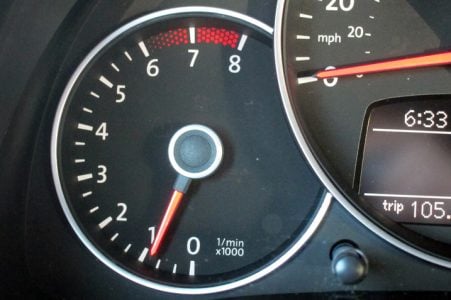 The transmission in your car is the most important part of the drive train besides your engine. The engine has a simple job; to create enough power to move the vehicle where and when you want it to. The transmission is responsible for transferring the engines power to the vehicle’s wheels at the right speed. The engine in your car is designed to run in a very specific range of RPMs, somewhere between an idle (500-1000 RPM) and the red line (3000-8000 RPM). The red line is the area on your tachometer, the gauge that reads engine speed, which is usually colored red by the manufacturer indicating it would be bad for your motor to operate at that speed. However, your vehicle is designed to operate at a wide variety of speeds from creeping through a parking lot to cruising down the highway, traveling below the speed limit of course.
The transmission in your car is the most important part of the drive train besides your engine. The engine has a simple job; to create enough power to move the vehicle where and when you want it to. The transmission is responsible for transferring the engines power to the vehicle’s wheels at the right speed. The engine in your car is designed to run in a very specific range of RPMs, somewhere between an idle (500-1000 RPM) and the red line (3000-8000 RPM). The red line is the area on your tachometer, the gauge that reads engine speed, which is usually colored red by the manufacturer indicating it would be bad for your motor to operate at that speed. However, your vehicle is designed to operate at a wide variety of speeds from creeping through a parking lot to cruising down the highway, traveling below the speed limit of course.
Accomplishing the goal of keeping your engine in its proper operating range while allowing your vehicle to move at a wide variety of speeds is a complicated task, but there are many ways to accomplish this. In different equipment many different kinds of transmissions are used, but in automobiles there are three main types of transmission that have been used from the Model-T until now: a manual or standard transmission, an automatic transmission and a continuously variable transmission (or CVT). You can now ask yourself:
What Transmission Do I Have?
Manual Transmission: Manual transmissions, also called standard transmission or stick shifts, are easy to identify. A vehicle with a manual transmission will have a few extra controls that automatic and continuously variable transmissions will not have. A manual transmission is called just that because the driver has to manually select which gear the vehicle is using. Which gear you are in is a function of the vehicle speed and desired engine speed, so a driver must be relatively skilled and have some knowledge of the engine and vehicle to operate it properly. A vehicle with a manual transmission will have a gear selector lever, the “stick” part of a stick shift, that is usually located between the front seats in easy reach of the driver. Some much older vehicles had this shift level located on the steering column. In a manual transmission, once the gear selector lever is in a gear, the engine, transmission and tires are locked together at that particular gear ratio. In order to change between ratios, a clutch, or a disconnect, is added in between the engine and transmission. The clutch is usually operated by a foot pedal besides the break pedel.
Automatic Transmission: Automatic transmissions are called such because they choose the gear ratio the vehicle should be using automatically and also change gears automatically, as driving conditions dictate. The automatic transmissions choose which gear to be in based on vehicle speed, engine speed and throttle position. Older automatic transmissions were based on hydraulic controls and pressure while newer automatic transmissions are computer controlled through sensors and electronics. Automatic transmissions can be identified while driving since you don’t have to shift, but on inspection, they can be identified by looking for the gear selector lever either between the seats or near the steering column. In a vehicle with an automatic transmission the gear selector lever will have the options of “Park” “Neutral” and “Drive” and may possible have a few more options such as “L” or “OD”
Continuously Variable Transmission: Consciously variable transmissions or CVTs have been around for many years, but until recently were not very popular in cars and trucks and were mostly used in small motor vehicles like scooters or off road vehicles. As gas prices have risen and more economical cars have been demanded by law and by people, the CVT has become a better option. Its ability to have an almost infinite number of gear ratios and ability to allow the engine to operate at its most efficient point help save gas and increase overall efficiency. Discovering if your car has a CVT can be difficult by just looking at the shift lever, and pedal arrangement may be identical to an automatic transmission. A few keys to look for would be a lack of shift points while driving and the type of transmission fluid that is recommended for your car. The best way to identify a CVT transmission in your vehicle is to look for the manufactures logos indicating one, such as Toyota’s Synergy Drive, Honda’s Multi Matic and Nissan’s Xtronic.
Finding out what transmission I have
If you are looking for the specific make or model of your transmission, the best way to find the information is to look for a casting number somewhere on the housing. This requires crawling under your vehicle, but that is part of the fun of working on your own car! Make sure your vehicle is well supported with blocked wheels and grab a flashlight. The easiest thing to spot will be the bell housing. It is the piece that connects your transmission to the engine and should be large and round. Look from the bell housing back towards where the drive shaft or an axle exits the transmission. Usually toward one end, often on the side you should find some numbers and/or letters either embossed or stamped into the metal. Write these numbers down, then wash up and head to the computer. Google is a great place to start searching those numbers and seeing what comes up. Those numbers will usually lead you to the identity of the specific transmission in your vehicle and answer the question “What transmission do I have?”
No matter what type of transmission you have, it requires some type of operating fluid to keep it working properly. If you find that fluid leaking while you are checking for serial numbers, add BlueDevil Transmission Sealer to your transmission immediately to stop the leak and save your transmission from costly failures.
BlueDevil Products can be found on Amazon.com or at AutoZone, Advance Auto Parts, O’Reilly Auto Parts, NAPA, and other major auto parts retailers.
3 responses to "What Transmission do I have?"
3 Comments
Leave a Reply
Related Articles




If I leave my vin# is there away u can pull up my manufacturer date on my transmission?..
Ashley-
Your best bet would be to call the dealer and see if they can look up the specific information for you.
Thank you!
-BDP
just go under your car, look at the bottom of your transmission there are some letters and number, for example in my hyundai accent 2017 is written : K- CVT TCL KN3 02300, that is tell me that my cars gear is cvt.